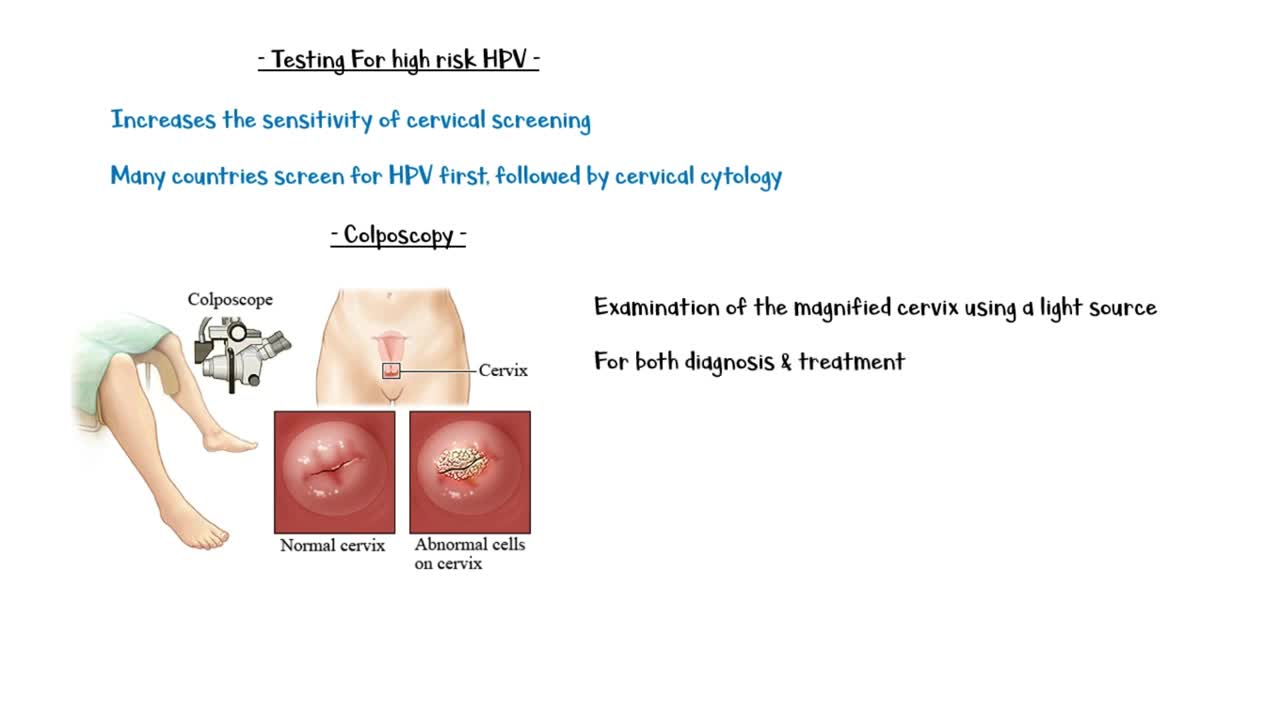Premium Only Content

Cervical Cancer _- Causes, Risk Factors, Signs & Symptoms, Diagnosis & Screening And Treatment
Cervical cancer, also known as cervical carcinoma, is the 3rd most common malignancy in women. And it is a leading cause of death for women in developing countries. In developed countries however, cervical cancer is relatively uncommon due to the availability of screening programs.
Cervical cancer is caused by persistent, high risk, Human Papilloma Virus infection. Which is a double stranded DNA virus of which there are more than 100 different types. Approximately 70% of the cervical cancers are squamous cell carcinoma’s, while most of the remainder is adeno carcinoma.
The cervix is approximately 2.5 cm in length. The upper part of the cervix mostly consists of involuntary muscle, whereas the lower part is mainly fibrous connective tissue. The epithelium of the endo cervix is columnar & is also ciliated in its upper two thirds. This changes to stratified squamous epithelium around the region of the external os as you can see in this picture, and the junction of these two types of epithelium is called the squamo columnar junction. Position of the squamo columnar junction varies throughout life. The area between the original squamo columnar junction and the current squamo columnar junction is called the transformational zone, And this is the site where cervical cancer develops.
As already mentioned, cervical cancer is caused by Human papilloma virus infection. More than 100 different types of this virus have been identified. These are classified as low risk & high risk types, depending on their ability to cause cancer. Low risk types, HPV 6 & 11 cause benign warts, whereas high risk types, HPV 16, 18, 31, 33, 45 cause cervical cancer. In most individuals, the infection is transient & no clinical consequences occur. However, in a minority of individuals, the infection is persistent, & there is a high risk for cervical cancer.
When HPV infection persists in certain individuals, it triggers an oncogenic process in the region of the transformational zone. Integration of viral DNA in to basal epithelial cells leads to immortalization and rapid cell proliferation. This process is called cervical intra epithelial neoplasia. And it is important to note that this is only the metaplastic state, and not the cancerous state. It may or may not progress in to cancer.
Stage 1 CIN indicates low grade disease, Whereas stage 2 & 3 CIN indicates high grade disease. If the basement membrane is breached, it is considered as cervical cancer.
Signs and symptoms of cervical cancer may vary depending on the extent of invasion. Small volume microscopic lesions are often asymptomatic, and detected incidentally. Most cervical cancers are friable, vascular masses on the cervix, and patients usually present with abnormal bleeding, typically post coital bleeding; Prolonged inter menstrual bleeding; And post menopausal bleeding. Any woman with these symptoms should therefore undergo a pelvic examination.
In more advanced cases, patient may also have the following symptoms. Abdominal pain. Urinary incontinence. Anemia. And renal failure.
Now let’s discuss about the diagnosis of cervical cancer. Complete evaluation starts with pap testing. Positive results in pap test should prompt colposcopy and biopsies, including excisional procedures. Pap testing was originally introduced by Papanicolaou. In this test, a small brush is used to sample cells from the transformational zone, und looked under the microscope after several preparations. For more than 95% of women, cervical cytology is normal.
Testing for high risk HPV increases the sensitivity of cervical screening. Colposcopy is the examination of the magnified cervix using a light source. it is used for both diagnosis and treatment. Application of acetic acid and iodine solutions highlights abnormal areas.
Imaging tests can be used to assess the distant spread of the cancer. MRI of the abdomen can be taken to look for local spread and lymphadenopathy. Chest X rays are taken to assess lung metastasis.
Finally let's come to the treatment. Low grade CIN regresses spontaneously in up to 60% of cases. Therefore, close follow up with colposcopy and cytology is recommended for CIN 1. By contrast, high grade CIN requires treatment with excision or ablation. This image shows a large loop excision of the transformational zone. For cervical cancer, surgery and radiotherapy are recommended, depending on the stage of the cancer.
#CervicalCancer #MedToday
-
 LIVE
LIVE
The Quartering
2 hours agoAirplane FLIPS and CRASHES, Sean Duffy Slams Pete Buttigieg, & What Happened with Patriarchy Hannah
2,664 watching -
 LIVE
LIVE
Russell Brand
2 hours agoLIVE FROM MAR A LAGO: US, Russia & China to Negotiate While UK Ramps Up in Ukraine – SF539
3,515 watching -
 LIVE
LIVE
The Charlie Kirk Show
1 hour agoThe Biggest Fraud in History? + Russian Peace Talks + Unhappy Boomers? | Gingrich, Rasmussen | 2.18
8,073 watching -
 58:11
58:11
The Dan Bongino Show
4 hours agoThis Is What Winning In Politics Looks Like (Ep. 2425) - 02/18/2025
579K842 -
 2:16:49
2:16:49
Steven Crowder
5 hours ago🔴 WINNING: Why Trump Has John Oliver & All of Europe Freaking Out
436K229 -
 1:04:20
1:04:20
Timcast
3 hours agoDemocrats Plan COUP In NYC After Mayor Defends Trump, Lets ICE Deport Criminals | Timcast LIVE
88.1K42 -
 LIVE
LIVE
TheAlecLaceShow
1 hour agoGuest: Victor Avila | Left Blames Trump For Canada Plane Crash | Tom Hanks TDS | The Alec Lace Show
230 watching -
 23:23
23:23
marcushouse
12 hours ago $0.32 earnedSpaceX Just Smashed Multiple Records! Wow!
4.31K4 -
 2:03:03
2:03:03
LFA TV
18 hours agoTRILLIONS IN FRAUD & WASTE FOUND! | LIVE FROM AMERICA 2.18.25 11AM
46.7K11 -
 35:40
35:40
Grant Stinchfield
1 hour ago $1.11 earnedPfizer Marketing Data Reveals 1223 Deaths in Just 10 Weeks Following COVID Vax Rollout
12.3K2